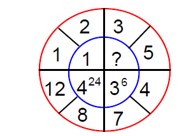Matrices
Get insights from 180 questions on Matrices, answered by students, alumni, and experts. You may also ask and answer any question you like about Matrices
Follow Ask QuestionQuestions
Discussions
Active Users
Followers
New answer posted
3 months agoContributor-Level 10
x + 2y + z = 2
αx + 3y – z = α
–αx + y + 2z = –α
Δ = | (1, 2, 1), (α, 3, -1), (-α, 1, 2) | = 1 (6+1) – 2 (2α–α) + 1 (α+3α) = 7+2α
α = –7/2
New answer posted
3 months agoContributor-Level 10
Given the matrix P = [2, -1], [5, -3].
The characteristic equation is det (P - λI) = 0, which is (2-λ) (-3-λ) - (-1) (5) = 0.
This simplifies to λ² + λ - 1 = 0.
By the Cayley-Hamilton theorem, the matrix P satisfies this equation: P² + P - I = 0, so P² = I - P.
To find P³: P³ = P * P² = P (I-P) = P - P² = P - (I-P) = 2P - I.
The problem asks for N=6, likely related to a higher power P? Continuing the pattern:
P? = 2P² - P = 2 (I-P) - P = 2I - 3P.
P? = 2P - 3P² = 2P - 3 (I-P) = 5P - 3I.
P? = 5P² - 3P = 5 (I-P) - 3P = 5I - 8P.
The solution N=6 must relate to a different question not fully transcribed, for example, if P^N = 5I - 8P.
New answer posted
3 months agoContributor-Level 10
1 = (2-1)¹ (The n is likely 1).
3? = (7-4)³ (This seems to be a pattern matching (a-b)^c).
4²? = (12-8)? ! = 4²?
The blank space must be (5-3)² = 2² = 4.
New answer posted
3 months agoContributor-Level 10
Evaluate the integral:
∫ (2x-1)cos (√ (4x²-4x+6) / √ (4x²-4x+6) dx
∫ (2x-1)cos (√ (2x-1)²+5) / √ (2x-1)²+5) dx
Let (2x-1)² + 5 = t².
Differentiating both sides:
2 (2x-1)*2 dx = 2t dt
2 (2x-1) dx = t dt
(2x-1) dx = (t/2) dt
Substitute into the integral:
∫ cos (t)/t * (t/2) dt
= 1/2 ∫ cos (t) dt
= 1/2 sin (t) + C
= 1/2 sin (√ (2x-1)²+5) + C
= 1/2 sin (√ (4x²-4x+6) + C
New answer posted
3 months agoContributor-Level 10
Given the equations:
t? (A + 2B) = -1 which expands to t? (A) + 2t? (B) = -1 . (I)
t? (2A - B) = 3 which expands to 2t? (A) - t? (B) = 3 . (II)
Solving equations (I) and (II) simultaneously, we get:
t? (A) = 1
t? (B) = -1
Therefore, t? (A) - t? (B) = 1 - (-1) = 2.
New answer posted
3 months agoContributor-Level 10
The system of equations has no solution if the determinant of the coefficient matrix is zero.
Δ = |k 1|
|1 k 1|
|1 k|
Δ = k (k² - 1) - 1 (k - 1) + 1 (1 - k) = 0
Δ = k³ - k - k + 1 + 1 - k = 0
⇒ k³ - 3k + 2 = 0 ⇒ (k - 1)² (k + 2) = 0
∴ k = -2, 1
If k = 1 then all the equations are identical (infinite solutions). Hence k = -2 for no solution.
New question posted
3 months agoNew answer posted
3 months agoContributor-Level 10
A = [ x 1 ]
[ 1 0 ]
A² = [ x 1 ] [ x 1 ] = [ x²+1 x ]
[ 1 0 ] [ 1 0 ] [ x 1 ]
A? = [ x²+1 x ] [ x²+1 x ]
[ x 1 ] [ x 1 ]
= [ (x²+1)²+x² x (x²+1)+x ]
[ x (x²+1)+x²+1 ]
a? = (x² + 1)² + x² = 109
⇒ x = ±3
a? = x² + 1 = 10
Taking an Exam? Selecting a College?
Get authentic answers from experts, students and alumni that you won't find anywhere else
Sign Up on ShikshaOn Shiksha, get access to
- 66k Colleges
- 1.2k Exams
- 680k Reviews
- 1800k Answers


